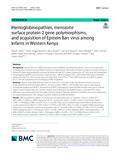| dc.description.abstract | Background
Epstein Barr virus (EBV)-associated endemic Burkitt’s Lymphoma pediatric cancer is associated with morbidity and mortality among children resident in holoendemic Plasmodium falciparum regions in western Kenya. P. falciparum exerts strong selection pressure on sickle cell trait (SCT), alpha thalassemia (-α3.7/αα), glucose-6-phosphate dehydrogenase (G6PD), and merozoite surface protein 2 (MSP-2) variants (FC27, 3D7) that confer reduced malarial disease severity. The current study tested the hypothesis that SCT, (-α3.7/αα), G6PD mutation and (MSP-2) variants (FC27, 3D7) are associated with an early age of EBV acquisition.
Methods
Data on infant EBV infection status (< 6 and ≥ 6–12 months of age) was abstracted from a previous longitudinal study. Archived infant DNA (n = 81) and mothers DNA (n = 70) samples were used for genotyping hemoglobinopathies and MSP-2. The presence of MSP-2 genotypes in maternal DNA samples was used to indicate infant in-utero malarial exposure. Genetic variants were determined by TaqMan assays or standard PCR. Group differences were determined by Chi-square or Fisher’s analysis. Bivariate regression modeling was used to determine the relationship between the carriage of genetic variants and EBV acquisition.
Results
EBV acquisition for infants < 6 months was not associated with -α3.7/αα (OR = 1.824, P = 0.354), SCT (OR = 0.897, P = 0.881), or G6PD [Viangchan (871G > A)/Chinese (1024 C > T) (OR = 2.614, P = 0.212)] and [Union (1360 C > T)/Kaiping (1388G > A) (OR = 0.321, P = 0.295)]. There was no relationship between EBV acquisition and in-utero exposure to either FC27 (OR = 0.922, P = 0.914) or 3D7 (OR = 0.933, P = 0.921). In addition, EBV acquisition in infants ≥ 6–12 months also showed no association with -α3.7/αα (OR = 0.681, P = 0.442), SCT (OR = 0.513, P = 0.305), G6PD [(Viangchan (871G > A)/Chinese (1024 C > T) (OR = 0.640, P = 0.677)], [Mahidol (487G > A)/Coimbra (592 C > T) (OR = 0.948, P = 0.940)], [(Union (1360 C > T)/Kaiping (1388G > A) (OR = 1.221, P = 0.768)], African A (OR = 0.278, P = 0.257)], or in utero exposure to either FC27 (OR = 0.780, P = 0.662) or 3D7 (OR = 0.549, P = 0.241).
Conclusion
Although hemoglobinopathies (-α3.7/αα, SCT, and G6PD mutations) and in-utero exposure to MSP-2 were not associated with EBV acquisition in infants 0–12 months, novel G6PD variants were discovered in the population from western Kenya. To establish that the known and novel hemoglobinopathies, and in utero MSP-2 exposure do not confer susceptibility to EBV, future studies with larger sample sizes from multiple sites adopting genome-wide analysis are required. | en_US |

